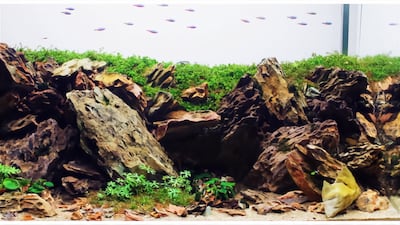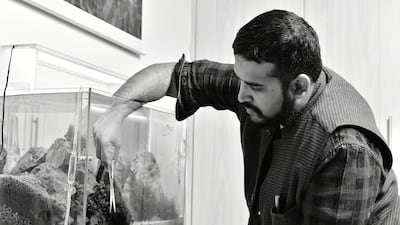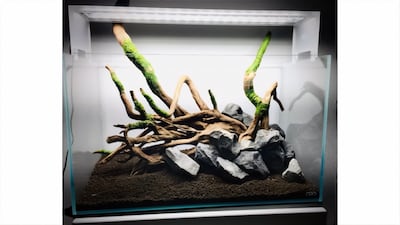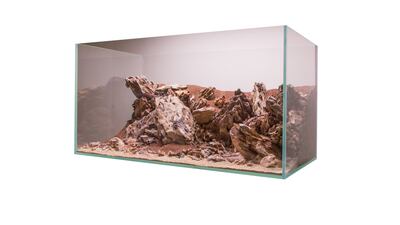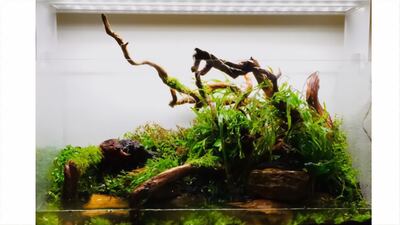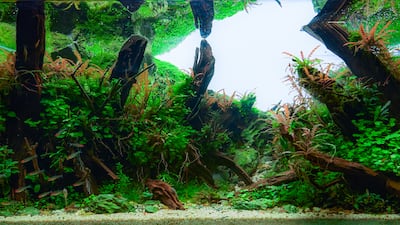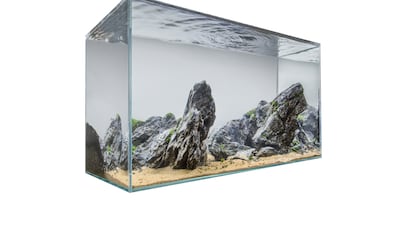Logs of tan-coloured driftwood lie scattered in Huzefa Goga’s studio office in Al Qusais, Dubai.
One of the few aquascaping artists in the UAE, Goga, 37, is busy slicing and glueing together pieces of driftwood to create his latest planted underwater landscape.
Titled Twists of Nature, as an ode to the knotted roots of trees, this aquascape will be adorned with aquatic plants, rocks and freshwater fish in a bid to emulate the river beds found amid forest trails.
“Aquascapes are living artworks built in water, where plants and fish co-exist in harmony. I recreate a natural landscape in an indoor space, which then grows and evolves over time,” says Goga.
These underwater tank gardens, carpeted with coloured pebbles and replete with rich foliage, marine life and even miniature mountains, caves and waterfalls, are live ecosystems. A step up from plastic plants and goldfish in a bowl, aquascapes are capturing people’s attention worldwide, and make for an aesthetic addition to one's living spaces.
Goga, who studied architecture and runs an industrial machinery business in the UAE, was inspired by Japanese aquascaping artist Takashi Amano.
“I made my first aquascape in 2014. From then on, it’s been a self-learning process. I mostly delve into experiences from my travels, books, movies and from my inner world to curate my tanks,” he explains.
Each aquascape is unique and bespoke, and can be customised as per buyer preferences. The artist’s last exhibition, called Nature and Me, for instance, featured aquascapes such as Miles to Go, which depicted a mini forest with a trail between mountains inspired by Robert Frost's poem Stopping by Woods on a Snowy Evening; Falling Waters, which showcased a waterfall in a tank and was named after a house designed by architect Frank Lloyd Wright; and We are the World and Redemption, which reflected Goga’s inner turmoil and how aquascaping helped him overcome it.
His creative process, then, starts with a theme that Goga researches online or in books to arrive at a visual landscape image he wants to create. He then starts sourcing material from vendors across the globe. Each tank is imported from Japan, and made of handcrafted low iron sapphire crystal glass, which is known for its high visibility. Tanks can range from 30 centimetres by 30cm to 800cm x 1,000cm.
It takes Goga up to one month to complete a tank. “Everything in the tank is sustainably sourced including the driftwood, which comes from Indonesia, Japan and Sri Lanka,” he says. “I also layer in lava rocks that are excellent for aquatic plants to grip on. Some of the rocks used are sourced from Ras Al Khaimah.
"I need to also keep a check on the limestone content as that can raise the pH level in the water.” A layer of substrate is added before the aqua soil to help cultivate the beneficial bacteria needed for plants to thrive.
Aquatic plants, obtained from tissue culture laboratories in Denmark, add to the greenery in Huzefa’s tanks. “You will find anubias from Western Africa with broad thick dark leaves; tropical bucephalandras that grow on stones and rocks; and bolbitis ferns and hygrophila pinnatifida, with their distinct reddish hued-leaves,” he says.
The fish are introduced towards the end. Goga prefers cardinal, neon and rummy-nose tetras, plus rainbow fish or guppies. Snails and shrimps are also a part of the floating fauna as they help keep a tab on the algae in an aquascape. The open-topped tanks are fitted with overhead lights and carbon dioxide cylinders that aid in plant photosynthesis.
“Patience and attention to detail are key in designing a great aquascape. It is, in fact, a combination of art and science. Aquascapers need to be mindful of the ecological environment of their tanks,” says Goga, who charges from Dh4,000 ($1,089) to Dh90,000 depending on the size and detailing of each tank. Upkeep includes replacing the water every week and trimming the plants when required.
In addition to showcasing his creations at various gallery exhibitions, Goga plans to open a permanent gallery space in Dubai to display his aquascapes.
Lost for hours and days adding details in his tanks, he says making aquascapes is extremely therapeutic. “I am so immersed in my tanks that I lose track of time, sometimes even days and nights. It's like giving birth to a child, and the beauty of it is you see the leaves take deeper hues and the fish change colour, even as the plants spread their roots wide.”
COMPANY PROFILE
Name: Kumulus Water
Started: 2021
Founders: Iheb Triki and Mohamed Ali Abid
Based: Tunisia
Sector: Water technology
Number of staff: 22
Investment raised: $4 million
The specs
Engine: 2-litre or 3-litre 4Motion all-wheel-drive Power: 250Nm (2-litre); 340 (3-litre) Torque: 450Nm Transmission: 8-speed automatic Starting price: From Dh212,000 On sale: Now
The specs
Engine: 4.0-litre V8 twin-turbocharged and three electric motors
Power: Combined output 920hp
Torque: 730Nm at 4,000-7,000rpm
Transmission: 8-speed dual-clutch automatic
Fuel consumption: 11.2L/100km
On sale: Now, deliveries expected later in 2025
Price: expected to start at Dh1,432,000
Tomb%20Raider%20I%E2%80%93III%20Remastered
%3Cp%3EDeveloper%3A%20Aspyr%0D%3Cbr%3EPublisher%3A%20Aspyr%0D%3Cbr%3EConsole%3A%20Nintendo%20Switch%2C%20PlayStation%204%26amp%3B5%2C%20PC%20and%20Xbox%20series%20X%2FS%0D%3Cbr%3ERating%3A%203%2F5%3C%2Fp%3E%0A
Auron Mein Kahan Dum Tha
Starring: Ajay Devgn, Tabu, Shantanu Maheshwari, Jimmy Shergill, Saiee Manjrekar
Director: Neeraj Pandey
Rating: 2.5/5
ENGLAND SQUAD
Goalkeepers: Jack Butland, Jordan Pickford, Nick Pope
Defenders: John Stones, Harry Maguire, Phil Jones, Kyle Walker, Kieran Trippier, Gary Cahill, Ashley Young, Danny Rose, Trent Alexander-Arnold
Midfielders: Eric Dier, Jordan Henderson, Dele Alli, Jesse Lingard, Raheem Sterling, Ruben Loftus-Cheek, Fabian Delph
Forwards: Harry Kane, Jamie Vardy, Marcus Rashford, Danny Welbeck
UAE currency: the story behind the money in your pockets
The lowdown
Bohemian Rhapsody
Director: Bryan Singer
Starring: Rami Malek, Lucy Boynton, Gwilym Lee
Rating: 3/5
Blue%20Beetle
%3Cp%3E%3Cstrong%3EDirector%3A%3C%2Fstrong%3E%20Angel%20Manuel%20Soto%3Cbr%3E%3Cstrong%3EStars%3A%20%3C%2Fstrong%3EXolo%20Mariduena%2C%20Adriana%20Barraza%2C%20Damian%20Alcazar%2C%20Raoul%20Max%20Trujillo%2C%20Susan%20Sarandon%2C%20George%20Lopez%3Cbr%3E%3Cstrong%3ERating%3A%20%3C%2Fstrong%3E4%2F5%C2%A0%3C%2Fp%3E%0A
Tamkeen's offering
- Option 1: 70% in year 1, 50% in year 2, 30% in year 3
- Option 2: 50% across three years
- Option 3: 30% across five years
Coffee: black death or elixir of life?
It is among the greatest health debates of our time; splashed across newspapers with contradicting headlines - is coffee good for you or not?
Depending on what you read, it is either a cancer-causing, sleep-depriving, stomach ulcer-inducing black death or the secret to long life, cutting the chance of stroke, diabetes and cancer.
The latest research - a study of 8,412 people across the UK who each underwent an MRI heart scan - is intended to put to bed (caffeine allowing) conflicting reports of the pros and cons of consumption.
The study, funded by the British Heart Foundation, contradicted previous findings that it stiffens arteries, putting pressure on the heart and increasing the likelihood of a heart attack or stroke, leading to warnings to cut down.
Numerous studies have recognised the benefits of coffee in cutting oral and esophageal cancer, the risk of a stroke and cirrhosis of the liver.
The benefits are often linked to biologically active compounds including caffeine, flavonoids, lignans, and other polyphenols, which benefit the body. These and othetr coffee compounds regulate genes involved in DNA repair, have anti-inflammatory properties and are associated with lower risk of insulin resistance, which is linked to type-2 diabetes.
But as doctors warn, too much of anything is inadvisable. The British Heart Foundation found the heaviest coffee drinkers in the study were most likely to be men who smoked and drank alcohol regularly.
Excessive amounts of coffee also unsettle the stomach causing or contributing to stomach ulcers. It also stains the teeth over time, hampers absorption of minerals and vitamins like zinc and iron.
It also raises blood pressure, which is largely problematic for people with existing conditions.
So the heaviest drinkers of the black stuff - some in the study had up to 25 cups per day - may want to rein it in.
Rory Reynolds
Specs
Engine: Dual-motor all-wheel-drive electric
Range: Up to 610km
Power: 905hp
Torque: 985Nm
Price: From Dh439,000
Available: Now
Our legal advisor
Ahmad El Sayed is Senior Associate at Charles Russell Speechlys, a law firm headquartered in London with offices in the UK, Europe, the Middle East and Hong Kong.
Experience: Commercial litigator who has assisted clients with overseas judgments before UAE courts. His specialties are cases related to banking, real estate, shareholder disputes, company liquidations and criminal matters as well as employment related litigation.
Education: Sagesse University, Beirut, Lebanon, in 2005.
